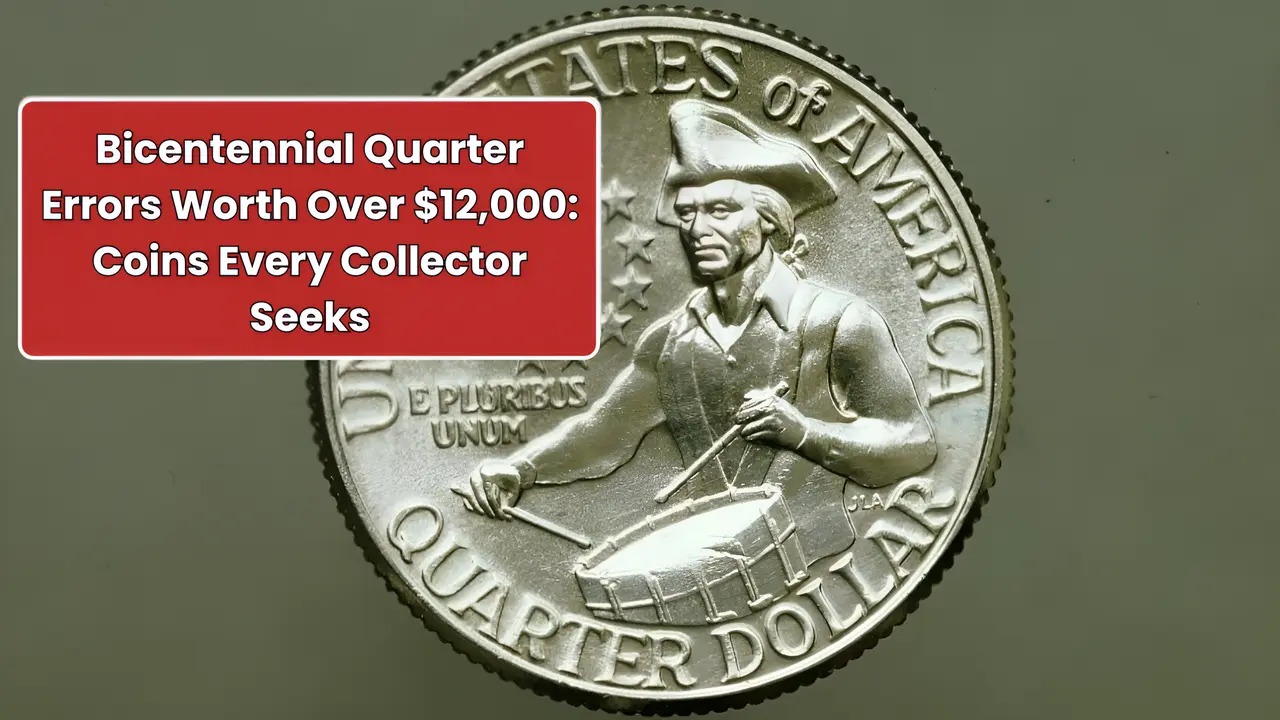Bicentennial quarters, minted to celebrate the United States’ 200th anniversary, are cherished not just for their commemorative value but also for the rare errors found in some coins. These mistakes make them incredibly desirable among coin collectors, with certain pieces fetching prices exceeding $12,000. Whether you’re a seasoned numismatist or a curious hobbyist, here’s what you need to know about these valuable quarters and the types of errors to look for.
What Makes Bicentennial Quarters Special?
Bicentennial quarters were minted in 1975 and 1976 to honor the 200th anniversary of the Declaration of Independence. These coins feature a unique reverse design of a colonial drummer boy and the dual date “1776–1976.”
They were issued in two primary varieties: circulation strikes made of copper-nickel and special collector’s editions in 40% silver. What sets some of these coins apart are the rare errors that occurred during production, making them highly valuable.
1. Double Die Obverse (DDO) Error
Description: This error occurs when a coin is struck twice, resulting in overlapping or doubled features, especially in the text or design elements.
Value: Depending on the clarity and severity of the doubling, these coins can range from $500 to over $12,000.
Why It’s Valuable: Clear doubling on the Bicentennial dates or inscriptions significantly increases a coin’s desirability.
2. Off-Center Strikes
Description: Coins struck off-center appear misaligned, with part of the design missing.
Value: These errors typically fetch between $1,000 and $5,000, depending on the degree of the misalignment.
Why It’s Valuable: The more dramatic the off-center strike, the rarer and more collectible the coin becomes.
3. Clipped Planchet
Description: A clipped planchet error occurs when a portion of the coin’s metal blank is missing before the design is struck.
Value: These coins can sell for $500 to $2,000 based on the size and location of the clip.
Why It’s Valuable: This unique minting mistake is highly sought after for its visual appeal and rarity
4. Missing Clad Layer
Description: Some Bicentennial quarters were struck with one of their outer metal layers missing, exposing the inner copper core.
Value: Coins with a missing clad layer can be worth $1,500 or more.
Why It’s Valuable: The missing layer gives the coin a distinctive appearance, making it a standout for collectors.
5. Die Breaks and Cuds
Description: Die breaks or cuds occur when a portion of the die used to strike the coin becomes damaged, leaving raised or irregular areas on the coin’s surface.
Value: These coins can range from $100 to $1,000, depending on the size and placement of the break.
Why It’s Valuable: Each die break is unique, adding to the collectibility of these coins.
6. Proof Errors
Description: Bicentennial proof coins, minted for collectors, occasionally feature errors such as strikes through foreign objects or design anomalies.
Value: Proof errors can command prices between $2,000 and $10,000.
Why It’s Valuable: Errors on proof coins are rare since they undergo more rigorous quality checks during production.
7. Transitional Errors
Description: Some Bicentennial quarters were mistakenly struck on planchets meant for other denominations or metals.
Value: Transitional errors are exceptionally rare, with some examples selling for over $12,000.
Why It’s Valuable: The mismatch in metal composition or size makes these coins extremely desirable.
How to Identify Bicentennial Quarter Errors
To identify errors, carefully examine your coins under magnification. Look for doubling, missing layers, misalignments, or unusual features. If you suspect you have a valuable error coin, consider getting it authenticated and graded by a professional service like PCGS or NGC.
FAQs
1. What is the most valuable Bicentennial quarter error?
Transitional errors, especially those struck on the wrong planchet, can fetch over $12,000, making them the most valuable among Bicentennial quarters.
2. How can I tell if my Bicentennial quarter has an error?
Inspect your coin for anomalies such as doubling, missing layers, off-center strikes, or unusual shapes. Using a magnifying glass or microscope can help identify these details.
3. Are all Bicentennial quarters valuable?
No, standard Bicentennial quarters in circulated condition are generally worth face value. Only those with errors or in high-grade uncirculated condition hold significant value.
4. Where can I sell Bicentennial quarters with errors?
You can sell them to coin dealers, at auctions, or through online marketplaces like eBay. Grading the coin beforehand can help maximize its value.
5. How much does it cost to grade a Bicentennial quarter?
Grading fees vary by service and coin value, typically ranging from $20 to $100. For highly valuable coins, professional grading is worth the investment.
6. Why are error coins valuable?
Error coins are valuable because they are unique and rare, often resulting from mistakes in the minting process that are seldom repeated.


Yes my name is Christopher Doss. I have some good coins. Please get back with me. 252-286-1364
okay